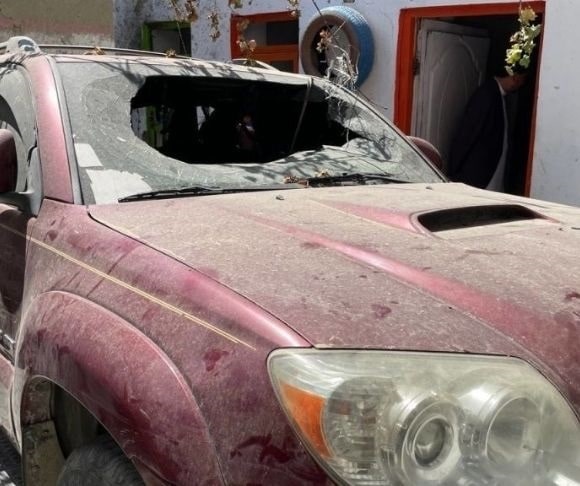There may be nothing more terrible in the heat of battle than to realize you have mistakenly killed friendlies. What appeared to be a rapid and precise operation to defeat another horrendous ISIS-K attack on service members at the Kabul airport turned out to be a tragic mistake based on faulty intelligence, resulting in the August 29 drone strike on innocent people. This unwarranted killing is consistent with what has been Biden’s abysmal leadership in the Afghan withdrawal.

A view of the damage at the family house where family of 10 including 7 children died after a drone strike a day before the final US evacuation flights from Kabul on September 18, 2021 in Kabul, Afghanistan. (Photo by Sayed Khodaiberdi Sadat/Anadolu Agency via Getty Images)
However, in this instance, the administration’s pitiful performance is evident in this horrible mistake, and it doesn’t get better with additional recriminations. Beating up the U.S. military leaders in congressional hearings and the media will not bring back the Afghan victims. Now, the focus must be on what went wrong with the intelligence.
Sitting in our living rooms in “Anytown USA,” it’s easy to second guess military leaders on the ground burdened with the responsibility of engaging the threat. Nonetheless, it is fair to raise two questions central to this U.S. missile attack – and answers from the Biden administration are critical. First, why was the airstrike authorized with what turned out to be such bad intelligence? Second, why was it necessary to act so precipitously in retaliation for the suicide bombing by ISIS-K at Kabul airport’s Abbey Gate on August 26?
The first question is difficult to answer. Gathering what is known as “actionable” intelligence is not a simple feat. Typically, when the purpose is to kill an enemy or destroy its combat capability, significant intelligence effort goes into identifying the target to eliminate and reduce the possibility of collateral damage. Such validation and verification rely on numerous sources and methods of information gathering. Ideally, U.S. forces would want to have human intelligence (HUMINT), the kind of word-of-mouth confirmation that comes from having reliable people on the ground that have proven themselves to be truthful and have a track record of providing accurate reporting.
Communications intelligence (COMINT) is very valuable and acquired by having access to cell phone conversations, text correspondence, and useful radio broadcasts. Imagery intelligence (IMINT) from satellite sensors or intelligence, reconnaissance, and surveillance aircraft document the comings and goings of targets on the ground. Any combination of HUMINT, COMINT, and IMINT is crucial for obtaining intelligence information.
Additionally, a procedure used to validate the conclusion arrived at by the intelligence community is known as the “pattern of life.” Pattern of life is developing a set of facts about a person’s activities over time. For example, people tend to have a regular sequence of things they do, and that pattern helps predict what they might do in the future.
 According to Armed Forces Connect, U.S. forces relied heavily on IMINT identification of a white Toyota Corolla. An Associated Press account published the same day as the missile strike reported the Corolla was thought to be carrying “multiple suicide bombers.” But there were no multiple persons in the car; just one hapless aid worker carrying water to his family.
According to Armed Forces Connect, U.S. forces relied heavily on IMINT identification of a white Toyota Corolla. An Associated Press account published the same day as the missile strike reported the Corolla was thought to be carrying “multiple suicide bombers.” But there were no multiple persons in the car; just one hapless aid worker carrying water to his family.
As Armed Force Connect points out, the problem with the reliance on the target vehicle’s model and color is that white Toyota Corollas are among the most common cars in Kabul; “… roughly 90% of the cars registered in Afghanistan are Corollas.” They are relatively inexpensive, and the white color does not show dirt as much as other colors. US Central Command commander General Kenneth F. (Frank) McKenzie “claimed that ground forces in Afghanistan had received some ’60 pieces of intelligence’ ahead of the strike that related to threats from the Islamic State group affiliate ISIS-Khorasan, suggesting ‘imminent threats…’” McKenzie’s statements do not shed light on whether any of those pieces of intelligence pointed to the targeted white Corolla.
McKenzie took responsibility for the mistake, as Liberty Nation told its readers:
“’I offer my profound condolences to the family and friends of those who were killed. This strike was taken in the earnest belief that it would prevent an imminent threat to our forces and the evacuees at the airport, but it was a mistake, and I offer my sincere apology. I am fully responsible.’”
 Perhaps the most telling of the statements that General McKenzie made was that conditions on the ground contributed to the errant strike. ‘We did not have the luxury to develop pattern of life,” The New York Times reported McKenzie as saying. Why was there no time to develop a pattern of life? The answer leads to question number two, what was the sense of urgency that required such haste?
Perhaps the most telling of the statements that General McKenzie made was that conditions on the ground contributed to the errant strike. ‘We did not have the luxury to develop pattern of life,” The New York Times reported McKenzie as saying. Why was there no time to develop a pattern of life? The answer leads to question number two, what was the sense of urgency that required such haste?
The first press announcement of the strike revealed a possible answer. As reported in the Associated Press, the drone strike was to ensure that no further ISIS-K attacks could be carried out during the “ongoing military evacuation at Kabul’s international airport.” But on reflection, the strike did not hit ISIS-K, the focus of concern, and there were no further attacks on the Kabul airport. So, the sense of urgency turns out to be unjustified.
An equally plausible explanation could be that with the bravado with which President Biden addressed the American people following the killing of 13 brave military members at Kabul airfield, action was required – any action. According to The New York Times transcript of the speech, Biden said:
“To those who carried out this attack, as well as anyone who wishes America harm, know this: We will not forgive. We will not forget. We will hunt you down and make you pay … We will not be deterred by terrorists. We will not let them stop our mission. We will continue the evacuation. I’ve also ordered my commanders to develop operational plans to strike ISIS-K assets, leadership, and facilities. We will respond with force and precision at our time, at the place we choose and the moment of our choosing.”
As of now, we know that “moment of our choosing” left no time for a thorough and necessary vetting of the required intelligence. Consequently, the rush to do something and the pressure on commanders in the field coming from the White House may have been the underlying and root cause of the tragic Predator drone strike. What needs to happen now is for Congress to establish a non-partisan, independent examination of what happened with the U.S. attack on a defenseless, totally blameless man and his family. Without such an investigation, the shadow of incompetence and negligence will hang over the military leadership in the field, while blame lies, in reality, higher up the chain.
The views expressed are those of the author and not of any other affiliation.
~
Read more from Dave Patterson.




